So you’ve been training to be a better fighter. Maybe you take classes or maybe you’ve read AoM’s numerous articles on self-defense and have been practicing with a friend. You are no Bruce Lee, but you feel like you could hold your own against the Average Joe or punk who means you harm.
But, what are you going to do if you are confronted by two, three, maybe ten opponents? Have you prepared for that?
Today we are going to give you some strategies for taking on multiple assailants, first talking about what will need to happen in your mind to be able to handle this scenario, before getting into specific tactics. Because when it comes to taking on a group of opponents, success depends less on what you do with your feet and fists (though that matters), and more on out-smarting your adversaries.
Zanshin (Situational Awareness)
Zanshin is a concept in Japanese martial arts that refers to a state of awareness, and is similar to the concept of situational awareness used in the West. Your Zanshin grows as you progress in your training as a fighter and martial artist, and the physical details of fighting become more ingrained — almost second nature. Once you arrive at this level of training, some of your mental faculties that once were entirely consumed by the fight are freed to focus on higher-level tactics.
If you’re in the beginning stages of learning martial arts, your mind is probably entirely focused on the nuts and bolts of the physical side of fighting — which moves and maneuvers to use in various situations. Your concentration is completely absorbed by your single opponent, and every fiber of your being is focused on staying alive; you have tunnel vision. At this stage, you are in fact probably reacting to your opponent instead of thinking proactively.
Even if you practice situational awareness, you will find that engaging with an opponent can quickly distract you from what is occurring around you. Because, unlike being in a code yellow state where you can passively take in your surroundings while doing a mundane task, once engaged in a conflict you have to actively divert your focus between what’s immediately in front of you (your opponent) and your surroundings (these include other combatants and bystanders, dangerous things you can fall into or tactically unsound positions, and potential weapons at your disposal to name a few), all while under extreme stress.
The more you master the physical skills and techniques of fighting, and heighten your Zanshin, the more you’ll be able to take in from your environment, the easier it will be to shift your attention back and forth between everything going on, and the quicker you’ll be able to react. You’ll be able to literally feel an attacker’s intent and respond to an attack you can neither hear nor see coming, which is a crucial skill when handling multiple combatants; when you’re taking on more than one assailant, you need awareness not only of who/what is directly in front of you, but also of the other opponents and their actions/movements.
So make it a point to focus on situational awareness not only in your daily life but in the heat of combat; what you notice may very well save your life.
With that mindset foundation in place, let’s dig into specific strategies.
Tactics for Fighting Multiple Opponents
First off, it is generally unwise to engage with multiple opponents, and it is probably best to flee (if you have been paying attention to your surroundings, hopefully you’ve already planned a good route of escape before the dangerous situation presents itself!). However, this is not always an option. Perhaps your opponents stand between you and your only escape or a potential weapon; maybe a loved one (or even just an innocent bystander) is in danger. For whatever reason, it is now necessary to engage more than one opponent.
As a side note, not all multiple-opponent fights start off that way; this is why it is important to maintain Zanshin and situational awareness. Often one person will start a fight and then their friends will become involved in the altercation.
Whether you are fighting two people or twenty, there are two basic principles for engaging multiple opponents at the same time: 1) Do not position yourself between two or more opponents, and 2) Do not let yourself get taken to the ground.
Utilize the Circling Technique to Neutralize One Threat at a Time
First, your location and placement is everything: the least safe place to be and the fastest way to lose a fight is in the middle of multiple people who want to hurt you. You can only effectively fight in one direction. Life isn’t a kung fu movie and you won’t knock two people out with a flying split kick. If you do find yourself in the unfortunate situation of being in the middle of multiple attackers, fight your way towards the edge of the crowd immediately.
Second, you can only effectively fight one person at a time.
So, we don’t want to be surrounded by our opponents and we want to set it up so that we only have to fight one combatant at a time. How do we do this?
To accomplish this, you need to get your opponents lined up. So, in a situation where you are fighting two people, one should be in front of you and the other one should be behind the one immediately in front of you. This way, as you apply your techniques to one opponent, the other can’t harm or disrupt you.
Now the funny thing about bad guys is that they don’t really do what you want them to do (without influence on your part) and will not line up for you to fight one at a time. That is why we have to apply the concept of circling.
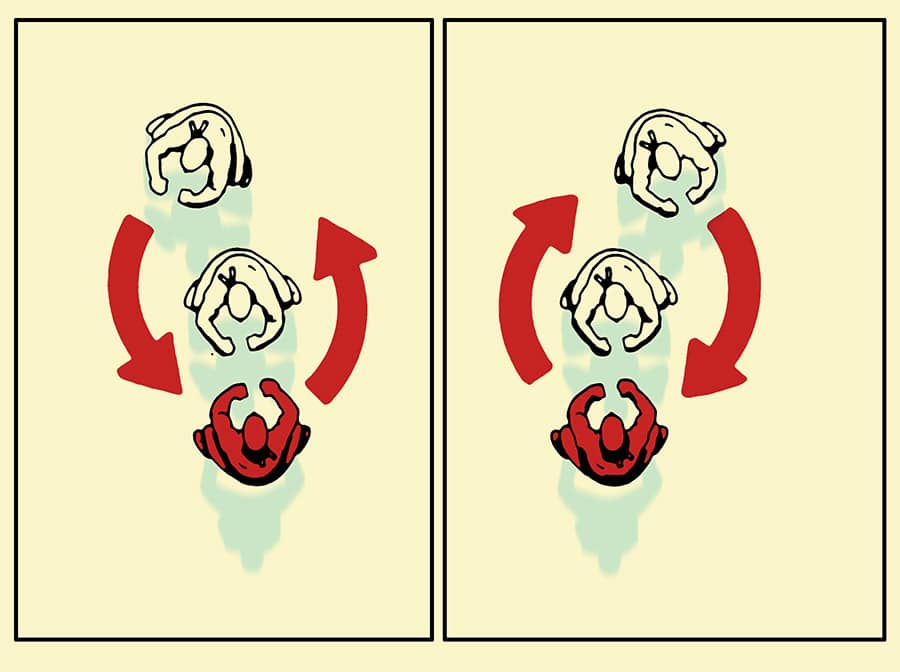
As the altercation begins, pick one opponent that you want to engage first (generally you will want to pick whoever is closest to you). Now circle around him so that the other opponent is directly behind the one you picked first. Then engage with the one in front. When the guy behind him tries to step around his friend to engage you, circle the same direction as he steps so that the guy you are fighting is always between you and his buddy who wants to help double-team you.
This tactic will allow you to fight one guy at a time and beat him down, and can potentially even cause the guy behind the one you are fighting to launch a wild strike, and he may end up striking his buddy or becoming tangled up with him.
Now, odds are good that eventually the guy behind the one you are engaged with will get tired of you beating up his friend and will rush around him to get to you faster than you can circle away from him. This is fine — now the roles are switched and you are directly engaged with the person who was previously behind, and the guy you were just fighting is now behind.
The same principle of lining up and circling applies to fighting more than two opponents as well. You want them all in a rough line — you just end up circling more and moving faster because there are more people moving around.
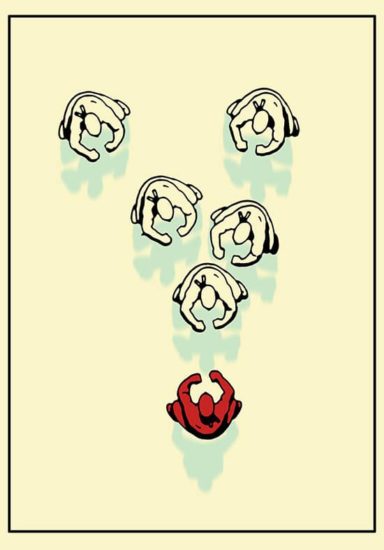
The principle of circling also allows you to get somewhere and in a position where you may be able to defend yourself more easily, like taking the high ground or finding a hallway to channel your attackers. It can also allow you to circle towards a weapon, like that baseball bat you spotted in the corner, or if the fight is happening in your house, a hidden pistol or a kitchen knife.
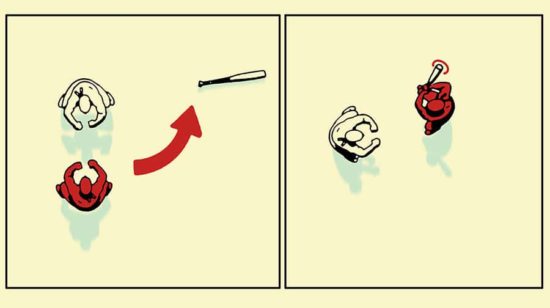
Additionally, the principle of circling can be used to position one or multiple opponents somewhere where you want him, like right where you can front kick him into that conveniently placed pool of piranhas.
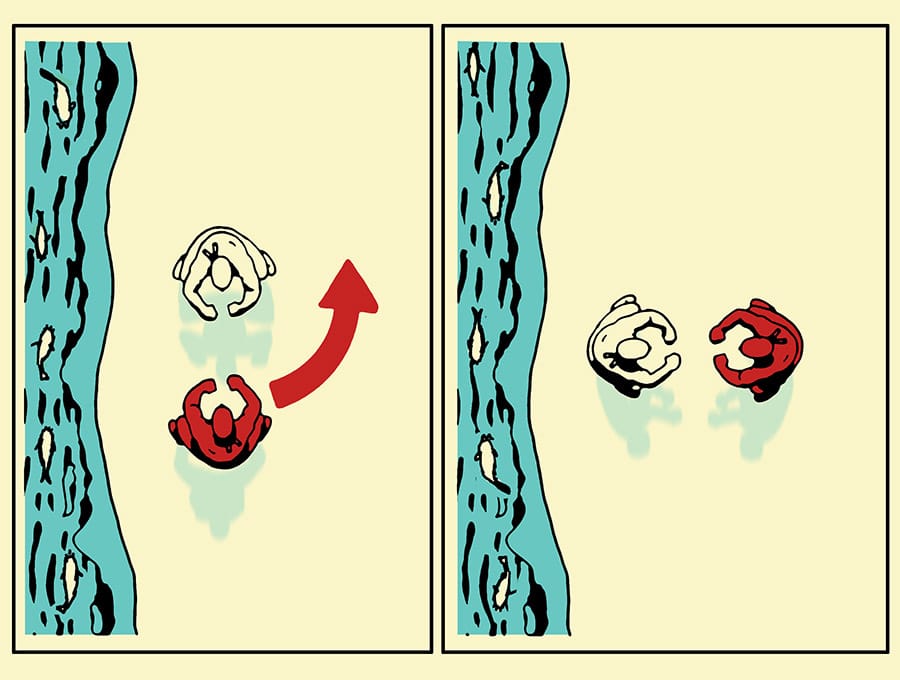
You can also circle around a stationary object in the same way that you would circle around an opponent. It can be a pillar, a sturdy table, anything that will slow your opponent down. Eventually your adversary will get tired of chasing you and leave you alone, or will rush around the corner to try to grab or strike you. The latter is actually a good thing because as soon as they rush around the corner they will likely be off balance and unready for an attack. Just have a solid strike ready for them as soon as they round the bend.
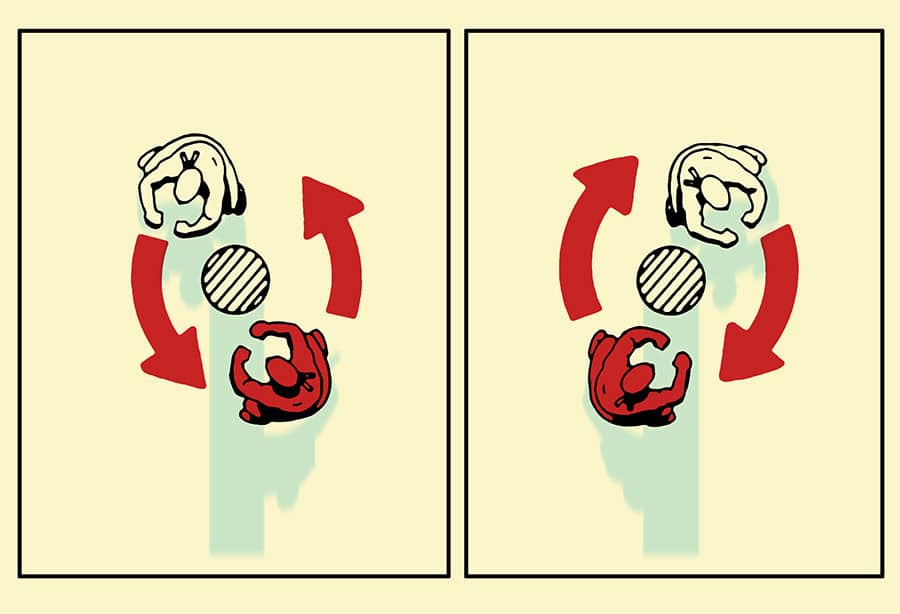
It is important as you circle to face the direction your opponent is moving towards you. Never turn your back on your opponent.
Don’t Let Yourself Get Taken to the Ground
In addition to keeping yourself from ever getting between two or more opponents by using the circling technique, you also need to try to avoid getting taken to the ground, where you will get pounded on by multiple people. If you do get taken to the ground, get to your feet as quickly as possible and make your way to the edge of the crowd so you can start circling again. This technique will also work if your opponents are armed with knives, clubs, even firearms to a small extent. If that is the case, though, you better work fast or be finding that escape.
Conclusion
Fighting multiple opponents isn’t easy. However, employing this strategy will make the fight much more manageable, and as long as you are a decent fighter already, it can make fighting multiple opponents seem much more like fighting one.
Stay safe, stay manly.
0 Comments